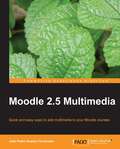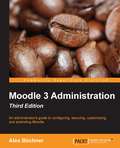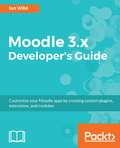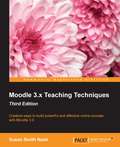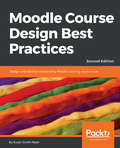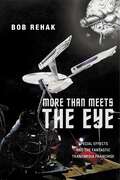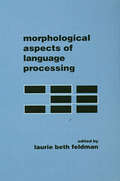- Table View
- List View
Monopoly Mail: Privatizing the United States Postal Service (The\economics Of The Service Sector In Canada Ser.)
by Douglas AdieFirst class postage rates have risen from six cents in 1971 to 25 cents in 1988. This rapid increase might be justifiable if service had improved commen-surately, but in fact postal service has steadily deteriorated. The Postal Service concedes that it takes ten percent longer to deliver a first class letter than it did in the 1960s, and one recent postmaster general admits that delivery may have been more reliable in the 1920s. In this volume, Adie reviews the failures of the U.S. Postal Service - an inability to innovate, soaring labor costs, huge deficits, chronic inefficiency, and declining service standards. He blames most of these problems on the postal service's monopoly status. Competition produces efficiency and innovation; monopoly breeds inefficiency, high costs and stagnation. He also examines the experiences of other countries and other industries that may be valuable in prescribing reform for the postal service. The breakup of AT&T provides lessons that may be applied to postal reform. The long-run effects of deregulation on the airline industry are also examined. Since the postal service has serious union problems, Adie looks at the air traffic controllers' strike and other evidence on pay and labor relations in government unions. Finally, Adie examines the experiences of Canada and Great Britain with privatization of government companies. He then offers a comprehensive - and controversial - reform plan for the U.S. Postal Service, with no further monopoly privileges or taxpayer subsidies. He argues that private companies should be free to compete with the Postal Service, and it, in turn, should be free to compete in all phases of the communications business. Without privatization and deregulation, the Postal Service is doomed to continuing inefficiency, rising costs, worsening labor relations, and an increasing loss of customers to more innovative and efficient service providers. Competition would give the Postal Service a chance to enter the 21st ce
Monsters
by L. Andrew Cooper Brandy Ball BlakeThe Fountainhead Press V Series is a new collection of single-topic readers that take a unique look at some of today's most pressing issues. Designed to give writing students a more nuanced introduction to public discourse--on the environment, on food, and on digital life, to name a few of the topics--the books feature writing, research, and invention prompts that can be adapted to nearly any kind of college writing class.
Monumental Fury: The History of Iconoclasm and the Future of Our Past
by Matthew FraserRecent years in America have seen Confederate monuments toppled, statues of colonizers vandalized, and public icons commemorating figures from a history of exploitation demolished. Some were alarmed by the destruction, claiming that pulling down public statues is a negation of an entire cultural heritage. For others, statue-smashing is justified vandalism against a legacy of injustice. Monumental Fury confronts the long-neglected questions of our relationship with statues, icons, and monuments in public spaces, providing a rich historical perspective on iconoclastic violence.Organized according to specific themes that provide insights into the erection and destruction of statues — from religion, war, and revolution to colonialism, ideology, art, and social justice — author Matthew Fraser examines the implications of our monuments from the Buddhas of Bamiyan to those of Napoleon Bonaparte, Abraham Lincoln, Robert E. Lee, Vladimir Lenin, and many more. Above all, the book endeavors to frame moments of statue-toppling throughout history so we can better understand the eruptions of iconoclastic violence that we are witnessing today.Statues are erected as expressions of power, and the impulse to destroy them is motivated by a desire to defy, reject, and eradicate their authority. However, the symbolic power of statues can stubbornly persist even after their destruction. This enduring paradox — between destruction and resurrection – is at the heart of this book. Fraser concludes with reflections that propose new ways of thinking about our relationship with statues and monuments and, more practically, about how we can creatively integrate their legacy into our collective memory in a way that inclusively enriches shared historical experience.
Moodle 2.5 Multimedia
by Joao Pedro FernandesA tutorial-based guide where readers can work through practical examples that clearly describe how to create multimedia applications using Moodle and integrate existing multimedia resources into Moodle courses.If you are a teacher or trainer who runs online courses and has a basic understanding of Moodle, this book will be ideal for you. It is not necessary to have an advanced technical background to create multimedia elements as the tasks will be simple, not time consuming, and will be practical for everyday use.
Moodle 2.7 LTS Administration - Third Edition
by Alex BuchnerThe book takes a problem-solution approach to fall in line with your day-to-day operations. This is a one-stop reference for any task you will ever come across when administering a Moodle site of any shape and size. If you are a technician, systems administrator, or part of academic staff, this is the book for you. This book is ideal for anyone who has to administer a Moodle system. Whether you are dealing with a small-scale local Moodle system or a large-scale multi-site Virtual Learning Environment, this book will assist you with any administrative task. Some basic Moodle knowledge is helpful, but not essential.
Moodle 3.x Developer's Guide
by Ian WildEffortlessly ensure your application's code quality from day 1 About This Book • Customize your Moodle 3.x app. • Leverage the new features of Moodle 3.x by diving deep into the Moodle development eco-system. • Cater to heavy user traffic, customize learning requirements and create custom third party plugins. Who This Book Is For This book is for Moodle developers who are familiar with the basic Moodle functionality and have an understanding of the types of scenarios in which the Moodle platform can be usefully employed. You must have medium-level PHP programming knowledge. You should be familiar with HTML and XML protocols. You do not need to have prior knowledge of Moodle-specific terminology What You Will Learn • Work with the different types of custom modules that can be written for Moodle 3.x • Understand how to author custom modules so they conform to the agreed Moodle 3.x development guidelines • Get familiar with the Moodle 3.x architecture—its internal and external APIs • Customize Moodle 3.x so it can integrate seamlessly with third-party applications of any kind • Build a new course format to specify the layout of a course • Implement third-party graphics libraries in your plugins • Build plugins that can be themed easily • Provide custom APIs that will provide the means to automate Moodle 3 in real time In Detail The new and revamped Moodle is the top choice for developers to create cutting edge e-learning apps that cater to different user's segments and are visually appealing as well. This book explains how the Moodle 3.x platform provides a framework that allows developers to create a customized e-learning solution. It begins with an exploration of the different types of plugin.. We then continue with an investigation of creating new courses. You will create a custom plugin that pulls in resources from a third-party repository. Then you'll learn how users can be assigned to courses and granted the necessary permissions. Furthermore, you will develop a custom user home. At the end of the book, we'll discuss the Web Services API to fully automate Moodle 3.x in real time. Style and approach This book takes a step-by-step practical approach with every step explained in great detail using practical examples. You will create custom plugins from scratch with the examples shown and create new modules as well as extensions with the examples presented.
Moodle 3.x Teaching Techniques - Third Edition
by Susan Smith NashCreative ways to build powerful and effective online courses with Moodle 3.0 About This Book * Unleash your teaching talents and develop exciting, dynamic courses * Put together effective online courses that motivate students from all backgrounds, generations, and learning styles * Find powerful insights into developing more successful and educational courses Who This Book Is For If you want to unleash your teaching talents and develop exciting, dynamic courses that really get students moving forward, then this book is for you. Experienced Moodlers who want to upgrade to Moodle 3.0 will find powerful insights into developing more successful and educational courses. What You Will Learn * Create a dynamic learning environment using different techniques * Motivate your students to collaborate and demonstrate what they are learning and to create projects together * Develop materials you can re-use in your future courses * Create online workshops and galleries for your students to make presentations about what they have learned * Engage your students in team work that helps them connect course content with their experiences and prior learning * Develop high-quality courses that will last to create a personal inventory you can use and re-use In Detail Moodle, the world's most popular, free open-source Learning Management System (LMS) has released several new features and enhancements in its latest 3.0 release. More and more colleges, universities, and training providers are using Moodle, which has helped revolutionize e-learning with its flexible, reusable platform and components. This book brings together step-by-step, easy-to-follow instructions to leverage the full power of Moodle 3 to build highly interactive and engaging courses that run on a wide range of platforms including mobile and cloud. Beginning with developing an effective online course, you will write learning outcomes that align with Bloom's taxonomy and list the kinds of instructional materials that will work given one's goal. You will gradually move on to setting up different types of forums for discussions and incorporating multi-media from cloud-base sources. You will then focus on developing effective timed tests, self-scoring quizzes while organizing the content, building different lessons, and incorporating assessments. Lastly, you will dive into more advanced topics such as creating interactive templates for a full course by focussing on creating each element and create workshops and portfolios which encourage engagement and collaboration Style and approach With clear, step-by-step instructions, this book helps you develop good, solid, dynamic courses that will last by making sure that your instructional design is robust, and that they are built around satisfying learning objectives and course outcomes. Packed with plenty of screenshots and practical examples, you will get solid understanding of developing courses that are a success in the real world.
Moodle Course Design Best Practices: Design and develop outstanding Moodle learning experiences, 2nd Edition
by Susan Smith NashFast-paced guide for designing effective Moodle courses; experiment with Moodle’s features for free using MoodleCloudKey FeaturesApply principles of instructional design to create great Moodle learning experiencesEnhance collaboration and spur creativity with MoodleBring together instructional materials, social interaction, and student management functions in your coursesBook DescriptionMoodle is a leading virtual learning environment for your online course. This book incorporates the principles of instructional design, showing you how to apply them to your Moodle courses. With this guidance, you will develop and deploy better courses, content, and assessments than ever.This book will guide you as you learn how to build and incorporate many different types of course materials and dynamic activities. You will learn how to improve the structure and presentation of resources, activities, and assessments. All this will help you to create better for self-led courses, instructor-led courses, and courses for collaborative groups. The use of multimedia features to enhance your Moodle courses is also explained in this book.Our goal is to encourage creativity, and the free MoodleCloud hosting option is an ideal place for teachers, students, trainers, and administrators to jump in and play with all the new features, which include powerful new plug-ins, new resources, and activities.Moodle can be your sandbox as well as your castle of learning! With this book, you will build learning experiences that will last your learners’ lifetimes.What you will learnBuild a course structure that fits your goalsDesign a unique appearanceManage the resources and activitiesTips for better organization of your course contentSelect and set up assessmentsInclude effective instructional strategiesIncorporate competency frameworksRun and archive webinarsMotivate learners by incorporating badgesExplore MoodleCloudWho this book is forIf you create courses with Moodle, this book is for you. It can be used by teachers, instructors, training managers, Moodle administrators, instructional technologists, instructional designers, and e-learning entrepreneurs. Prior experience with Moodle will be helpful.
Moose Memoirs and Lobster Tales: As True as Maine Stories Ought to Be
by John McDonaldJohn McDonald has been making people laugh for decades with his humorous yarns poking fun at people from away, people from Maine, and life in general. Following up the wildly popular A Moose and a Lobster Walk into a Bar, the "Dean of Maine Storytelling" offers a new collection of stories that will make you laugh till you cry and cry till you laugh. Here's a new round of classic stories brimming with half truths, stretched truths, and wry observations about life in Maine.
Moral Consciousness And Communicative Action
by Jürgen Habermas Christian Lenhardt Shierry Weber NicholsenThis long-awaited book sets out the implications of Habermas's theory of communicative action for moral theory. "Discourse ethics" attempts to reconstruct a moral point of view from which normative claims can be impartially judged. The theory of justice it develops replaces Kant's categorical imperative with a procedure of justification based on reasoned agreement among participants in practical discourse. Habermas connects communicative ethics to the theory of social action via an examination of research in the social psychology of moral and interpersonal development. He aims to show that our basic moral intuitions spring from something deeper and more universal than contingent features of our tradition, namely from normative presuppositions of social interaction that belong to the repertoire of competent agents in any society. Jürgen Habermas is Professor of Philosophy at the University of Frankfurt.
More Adventures in Contemporary Electromagnetic Theory
by Francesco Chiadini Vincenzo FiumaraThis book describes some recent advances in electromagnetic theory, motivated and partly informed by developments in engineering science and nanotechnology. The collection of chapters provided in this edited book, authored by leading experts in the field, offers a bird’s eye view of recent progress in electromagnetic theory, spanning a wide range of topics of current interest, ranging from fundamental issues to applications.
More Awesome Than Money
by Jim DwyerDavid versus Goliath in Silicon Valley--an epic attempt to take back the Internet Their idea was simple. Four NYU undergrads wanted to build a social network that would allow users to control their personal data, instead of surrendering it to big businesses like Facebook. They called it Diaspora. In days, they raised $200,000, and reporters, venture capitalists, and the digital community's most legendary figures were soon monitoring their progress. Max dreamed of being a CEO. Ilya was the idealist. Dan coded like a pro, and Rafi tried to keep them all on track. But as the months passed and the money ran out, the Diaspora Four fell victim to errors, bad decisions, and their own hubris. In November 2011, Ilya committed suicide. Diaspora has been tech news since day one, but the story reaches far beyond Silicon Valley to the now urgent issues about the future of the Internet. With the cooperation of the surviving partners, New York Times bestselling author Jim Dwyer tells a riveting story of four ambitious and naÏve young men who tried to rebottle the genie of personal privacy--and paid the ultimate price.
More Awesome Than Money
by Jim DwyerThe David-versus-Goliath effort to build a revolutionary social network that would give us back control of our personal data In June of 2010, four nerdy NYU undergrads moved to Silicon Valley to save the world from Facebook. Their idea was simple--to build a social network that would allow users to control the information they shared about themselves instead of surrendering it to big business. Their project was called Diaspora, and just weeks after launching it on Kickstarter, the idealistic twenty-year-olds had raised $200,000 from donors around the world. Profiled in the New York Times, wooed by venture capitalists, and cheered on by the elite of the digital community, they were poised to revolutionize the Internet and remap the lines of power in our digital society--until things fell apart, with tragic results.The story of Diaspora reaches far beyond Silicon Valley to today's urgent debates over the future of the Internet. In this heartbreaking yet hopeful account, drawn from extensive interviews with the Diaspora Four and other key figures, Pulitzer Prize-winning journalist Jim Dwyer tells a riveting tale of four ambitious and naive young men who dared to challenge the status quo.
More French Slanguage: A Fun Visual Guide to French Terms and Phrases (Slanguage Ser.)
by Mike EllisQuad enough? A fun way to learn French phrases through entertaining illustrations and an easy pronunciation guide!With this volume in the best-selling Slanguage series, Mike Ellis provides translations and pronunciation guides for nearly three hundred more French words and phrases, focusing on such categories as clothing and fashion, dining, entertainment, cooking and baking, and destinations. These guides are a breeze to use—and ideal for kids or adults who want a fun way to learn the basics of a new language. Just use the simple pronunciation guide that incorporates easy English terms and helpful illustrations, and you’ll be saying things like “What’s up?” (Quad Enough) and “Kisses, sweetie” (Bee Zoo Shoe Shoe) in no time!
More Lives Than One: The Extraordinary Life of Felix Dennis
by Fergus ByrneCanny, infuriating, cynical and generous by turns, Felix Dennis was a true one-off. When he died in 2014 he was a multi-millionaire. Yet he spent his last months writing poetry and planting the millionth tree in his own forest in Warwickshire. Journalist Fergus Byrne got to know him well in this time and was granted exclusive access to Dennis's archives and papers. He found everything had been kept and, along with hours of interviews with girlfriends, family, staff and friends the world over, he has now written the only authorised biography of a man who described himself as lucky to have led several lives.His early rebellious days started with dropping out of grammar school, playing in a rock 'n' roll band, and being imprisoned (with Richard Neville and Jim Anderson) for charges of obscenity relating to a priapic Rupert Bear in the 'schoolkids' issue of the magazine Oz. The launch of Kung-Fu magazine, created when Dennis spotted a queue at a Leicester Square cinema for a Bruce Lee film, changed his fortunes. An industrious and self-destructive era then followed. He moved to America, added the magazines MacUser and Maxim to his portfolio, but also discovered crack, hookers and S & M. When his lifestyle led him to hospital, he gave up the drugs overnight and took to writing poetry. He acquired a mansion in Warwickshire, bought a much loved home in Mustique from rock star David Bowie, gave generously to charities, planted the largest broadleaf forest in Britain, and published several volumes of verse promoted by very well received readings nationwide. This is a hugely readable account of one of the most extraordinary characters of our time.
More Love Less Conflict: A Communication Playbook for Couples (Easy And Effective Tools To Create More Love And Less Conflict Ser.)
by Jonathan RobinsonA practical guide &“brimming with wonderful ideas and methods that can help any couple experience a deeper, more profound connection&” (John Gray, author of Men Are from Mars, Women Are from Venus). More Love Less Conflict teaches readers how to communicate effectively and get more out of love. Whether debating with your parents, trying to convince your boss, or romancing your significant other, the importance of communication skills in your day-to-day life is undeniable. Through the strategies outlined in this essential guide, you can become a better listener, practice open communication, and be capable of handling almost any situation with confidence and compassion. As psychotherapist and bestselling author Jonathan Robinson explains, communication is, like love, something to work on and get better at through conscious practice. Robinson introduces ways for couples to build a foundation of love and connection, engage in crucial conversations, understand unique needs, spot a partner&’s triggers, overcome communication barriers—and clear the path for love, fun, and affection.
More Nitty-Gritty Grammar: Another Not-So-Serious Guide to Clear Communication
by Judith Pinkerton Josephson Hope Edith FineWho or whom? Lay or lie? Conjunction, pronoun, predicate, or gerund? If such questions and terms leave you scratching your head, you need the hip and fun follow-up to NITTY-GRITTY GRAMMAR. With a new, easy-to-use alphabetical format and the same winning formula of wacky cartoons, off-the-wall examples, and catchy reminders, MORE NITTY-GRITTY GRAMMAR will help you sidestep common bloopers, untangle your malapropisms, secure those dangling modifiers, and teach you to speak and write with clarity and confidence.From the Trade Paperback edition.
More Than Meets the Eye: Special Effects and the Fantastic Transmedia Franchise (Postmillennial Pop #19)
by Bob RehakA rare look at the role of special effects in creating fictional worlds and transmedia franchises From comic book universes crowded with soaring superheroes and shattering skyscrapers to cosmic empires set in far-off galaxies, today’s fantasy blockbusters depend on visual effects. Bringing science fiction from the studio to your screen, through film, television, or video games, these special effects power our entertainment industry. More Than Meets the Eye delves into the world of fantastic media franchises to trace the ways in which special effects over the last 50 years have become central not just to transmedia storytelling but to worldbuilding, performance, and genre in contemporary blockbuster entertainment. More Than Meets the Eye maps the ways in which special effects build consistent storyworlds and transform genres while traveling from one media platform to the next. Examining high-profile franchises in which special effects have played a constitutive role such as Star Trek, Star Wars, The Matrix, and The Lord of the Rings, as well as more contemporary franchises like Pirates of the Caribbean and Harry Potter, Bob Rehak analyzes the ways in which production practices developed alongside the cultural work of industry professionals. By studying social and cultural factors such as fan interaction, this book provides a context for understanding just how much multiplatform storytelling has come to define these megahit franchises. More Than Meets the Eye explores the larger history of how physical and optical effects in postwar Hollywood laid the foundation for modern transmedia franchises and argues that special effects are not simply an adjunct to blockbuster filmmaking, but central agents of an entire mode of production.
More Than Meow: How Cats Communicate (Fountas & Pinnell LLI Red #Level L)
by Chris BoudreauxWhat if cats could talk? Actually, they can talk, but not with words. Find out how cats use their bodies and sounds to tell you and other cats what they want and how they feel.
More Than Words: An Introduction to Communication
by Graeme Burton Richard DimblebyThis new edition of the best-selling text has been fully revised and updated to take into account new developments in communication and media studies. More Than Words provides an introduction to both communication theory and practice. The authors cover essential elements of communication, including communication between individuals and groups, in organizations and through mass media and new technologies.The fourth edition features:new case studies and assignmentsan updated series of key questions helping students to understand central concepts in communication studiesexpanded sections on mass media and on practical communication and media skillsguidance on listening skills, interpersonal and social skills, writing skills, leaflet design, and planning, scripting, and producing audio and video material.More Than Words is illustrated with new models and photographs and has checklist summaries for easy revision purposes. Clear and practical, it is an essential text for students of communication studies.
Morning Sunshine!: How to Radiate Confidence and Feel It Too
by Robin MeadeRobin Meade is the poster child for confidence and self-assurance. But the anchor of Morning Express with Robin Meade wasn't always that way. In fact, there was a period in her career when she was plagued with anxiety and panic attacks. In MORNING SUNSHINE, she tells how she overcame her fear of public speaking to go on and achieve her dream of becoming a news anchor. Robin Meade offers her own tried-and-true four-step approach to building confidence. Her trademark warm, personal style translates from the screen to the page in this book, which will give readers even more insight into the young woman who came out of nowhere to become one of the most popular news anchors on television today.
Morphological Aspects of Language Processing
by Laurie Beth FeldmanIt is now well established that phonological -- and orthographic -- codes play a crucial role in the recognition of isolated words and in understanding the sequences of words that comprise a sentence. However, words and sentences are organized with respect to morphological as well as phonological components. It is thus unfortunate that the morpheme has received relatively little attention in the experimental literature, either from psychologists or linguists. Due to recent methodological developments, however, now is an opportune time to address morphological issues. In the experimental literature, there is a tendency to examine various psycholinguistic processes in English and then to assume that the account given applies with equal significance to English and to other languages. Written languages differ, however, in the extent to which they capture phonological as contrasted with morphological units. Moreover, with respect to the morpheme, languages differ in the principle by which morphemes are connected to form new words. This volume focuses on morphological processes in word recognition and reading with an eye toward comparing morphological processes with orthographic and phonological processes. Cross-language comparisons are examined as a tool with which to probe universal linguistic processes, and a variety of research methodologies are described. Because it makes the experimental literature in languages other than English more accessible, this book is expected to be of interest to many readers. It also directs attention to the subject of language processing in general -- an issue which is of central interest to cognitive psychologists and linguists as well as educators and clinicians.
Morson's English Guide for Court Reporters (2nd Edition)
by Lillian I. MorsonThis guide presents the fundamental rules for punctuating acceptable syntax and then goes a step further and presents verbatim English as found in courtroom transcripts and modifies the rules to accommodate this English. The grammar section and glossary offer a look at the way we name and define the elements in a sentence so that we can better understand standard word usage, spelling, and punctuation.
Mortgage Rip-offs and Money Savers: An Industry Insider Explains How to Save Thousands on Your Mortgage or Re-Finance
by Carolyn Warren&“Identifie[s] all the major dangers amateur real estate investors need to be aware of . . . many useful tips for getting the right price and the best financing.&” —Michael Masterson, New York Times–bestselling author of Automatic Wealth Mortgage Rip-offs and Money Savers reveals how the mortgage industry cheats borrowers out of billions in extra costs every year. Industry insider Carolyn Warren taps her decade of experience with lenders to expose the tricks, lies, and dirty little secrets they don&’t want you to know. With her expert guidance, borrowers will save tens of thousands when they avoid the traps so many consumers fall into. Having this inside information is the only way borrowers can truly get the best possible deal. This book presents that knowledge in an interesting and easy format that anyone can understand. Readers can void being victims of the mortgage industry with this invaluable resource. Instead, they&’ll get the best possible rates, avoid bogus fees, and get the great deal they deserve.
Moscow Calling: Memoirs of a Foreign Correspondent
by Angus RoxburghA British journalist offers an intimate view of Russia from the Cold War to the rise of Putin through his personal experiences as a correspondent. In the course of the past 45 years, Angus Roxburgh has translated Tolstoy, met four successive Russian presidents and been jinxed by a Siberian shaman. He has come under fire in war zones and been arrested by Chechen thugs. During the Cold War he was wooed by the KGB, who then decided he would make a lousy spy and expelled him from the country. In Moscow Calling, Roxburgh presents his Russia: not the Russia of news reports, but a quirky, exasperating, beautiful, tumultuous world that in four decades has changed completely—and not at all. Roxburgh narrates an incredible journey from the dark, fearful days of communism and his adventures as a correspondent covering the Soviet Union&’s collapse to his frustrating work as a media consultant to Putin&’s Kremlin. His memoir offers a unique, fascinating and at times hilarious insight into a country that today, more than ever, is of global political significance.



